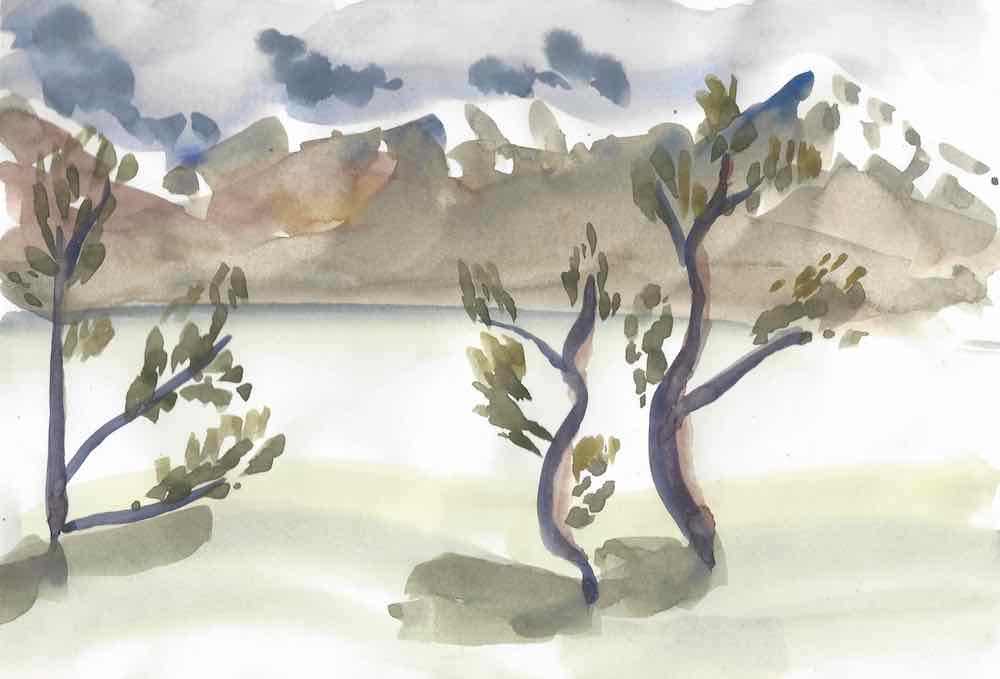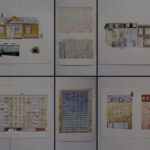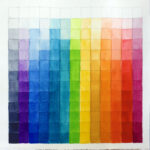What’s in a gesture? With a wave of the hand, the conductor signals to the orchestra to start the symphony; the artist begins painting a bare canvas, or a camera operator starts rolling film. A gesture can be inviting, beckoning strangers to enter or open up; it can also be detached, as when someone demonstrably displays their reticence by crossing their arms. Everyone has experienced warm gestures from friends, or vulgar gestures from strangers. Sometimes we talk about empty gestures, as when the performance of an action outweighs its authenticity. There is a seeming incongruity here, between the meaning of the action, and the word that describes it; between the thing that does, and the act of doing. A grand gesture does the opposite, generously rewarding recipients, but remaining tied to its semantic meaning, being simply a gesture.
I am “writing” this text via dictation, speaking into the microphone of my writing software; kinesthetic clickety-clack motions of fingers on keys replaced by my awkwardly parsed, yet commanding voice. I wonder what the neighbours will think. My wrist is recuperating from a repetitive strain injury, and while it rests idly by my side, it’s inaction puts the privilege of mobility, and the tremendous number of things I take for granted, into perspective. I edit the text with voice commands, dictating punctuation, selecting words, sentences, or entire paragraphs to move about or excise from my oeuvre. In light of my present powerlessness, I feel like a god of type, exerting reign over my 12-point kingdom.
We talk of artists calling an image into being; I feel like I’m doing that literally (pun intended). If we were to defamiliarize ourselves from the words on the page, then the kern and ligatures of each letter may appear as a foreign language; as a geometric abstraction; as a work of art. However, what I see reflected on the page is qualitatively different from what I used to write or type some days ago. It is different both in content: my sentence structure and syntax have changed, and in tone: conversational English, after all, is a different kettle of fish – forgive the colloquialism. But dictating text to voice recognition software is not at all like having conversation, because it’s hard to hide that you’re essentially talking to yourself. When I write, however, I often imagine an abstract, yet sympathetic audience. I’m a fast typist, and words sputter out almost as quickly as I have a chance to think them. Thoughts meander, yet they can be craftily rearranged to make meaning post factum. Considering I often say that I think when I speak, I’m finding it strange that the quality of my dictated thoughts appears stunted and slow.
What’s in a gesture? For those people who communicate by signing, it is a way of using language. The American Sign Language gesture for architecture is an arc constructed using a downward parabola of two thumbs moving away from each other. A gesture then, can encompass a whole method of communication. But gestures can also happen when words fail, as when a foreign-language speaker does not manage to communicate their intended message using a limited vocabulary.
Anthropologist Keith Basso reflects on his initial confusion as he was getting acquainted with his fieldwork milieu amongst the Western Apache, especially in the conversations he heard about the surrounding landscape. The author demonstrates how the Western Apache interpret and construct their natural surroundings using language: “landscapes and the places that fill them become tools for the imagination, expressive means for accomplishing verbal deeds” (Basso 1998:102). Physical environments are appropriated, evoked, and used as symbolic reference points for cultural narratives:
“It happened at line of white rocks extends upward and out, at this very place!” (Basso 1998:105)
This story, uttered as a moral lesson, is tied to a place, connecting an ancestral myth that happened at the line of rocks, with an example of a moral transgression witnessed in the present. Thus, a gesture was used as a substitute for a narrative (Basso 1998:112-114), and was then used to convey a meaning, or an idea.
DeCerteau describes how walking enunciates pedestrian action in a city; pedestrians appropriate the topography much like speakers appropriate language, and walking becomes a speech act. Walking, “an individual’s fundamental way of being in the world,” (1984:100), translates action into movement, and movement into action. Within the built, stratified environment of a city, walking has its own style, its own language, which forms “trees of gesture” (102). In this way, embodied spatial practices translate rhetorical gestures into action.
Alexey Yurchak argues that in the last years of socialism, these very actions lead to a central paradox of the Soviet Union, whereby certain procedural requirements, such as voting, or marching in demonstrations, had to be accurately performed, but were no longer believed in:
In most contexts where that discourse circulated and was dominant it became less important to interpret its texts and rituals literally, as constative descriptions of reality, and more important to reproduce them with great precision. Its performative dimension became profoundly important, having opened the realm of creative innovation, unpredictable meaning, and reinterpretation of socialist life. (Yurchak 2006:286)
Formerly sacrosanct rituals re-enacting the the Soviet origin story became empty gestures, devoid of meaning.
In drawing, the gesture is something different. It is not an invocation, or a call to action, but an exploration within action, a message delivered with the minimum number of lines conveying reality as seen before us, and as explored by the movement of the hand, the wrist, the entire body. a gesture is a loose movement of the hand, meant to convey observed reality using a minimal amount of information. The rhythm, force, movement, and strength of a line begin to communicate volumes and shapes, reality as it is perceived and experienced. A gesture is an exploration, a way to discover how things relate, how to convey an infinitely rich, textured reality using basic forms, built out of lines, masses, and planes. It is an immediate translation of experienced reality.
Gesture can also be mediated, in that information may be stored in a medium that delivers the message. In his eloquent message, Benson argues that the main difference between printmaking and painting lies with where information is stored. His assessment, is that a painted picture has its impression stored in the mind of the artist, but a print stores information in the printmaking media–a linocut, a lithograph, or even, and perhaps especially so, in a stencil. Richard Benson describes this phenomenon in one of the earliest instances of human creative achievement, in 30,000 year old pictures in cave walls in Europe:
Mixed in with hand-drawn pictures in the caves are clear examples of printing. The most common of these printed pictures are of the human hand. Sometimes the images dark, obviously made by impressing of pigment-covered hand onto the wall, while in other cases the hand appears as a negative, clear but surrounded by colored material… The positive images (those made by the hand itself carrying the pigment) are examples of relief printing, the system that underlies printing with movable type or with wood or linoleum blocks. The negative images (those blank hands surrounded by colored pigment) are examples of stencil printing, in which image-bearing pigment is passed through or around some form that holds the picture information (Benson 2008:4).
The medium, indeed, is the message (McLuhan 1964).
In architecture, gesture takes on yet another meaning. Everyone has heard of the infamous napkin sketch: this is, supposedly, how many architects think up designs for landmark buildings. The architectural tradition of draftsmanship to represent and visualize the built environment stems to antiquity. In the Italian Renaissance, the plan, design, or disegno,
is transmitted onto the physical space of the page as ‘an apparent expression and articulation of the conceit that one has in the mind,’ hidden beneath the finished image lies the latent body of its creator. (Andrews 137)
This is contrasted with drawings, or disegni, which are “the result have training that enables the hand of the artist or architect to act as a conduit into the recesses of the human mind” (Ibid.). One process relates to the representation of space, while of the other has to do with the materiality of the image. According to Andrews, it is the gestural line that most readily embodies the movement of the hand that created it (Andrews 141). However, this language of space had first to be invented. Erwin Panofsky contends that to develop a conceptual language of space, the space of the design had to extend beyond the frame of the picture. This was the discovery of perspective, described as “imagined space [that] now reaches out in all directions beyond represented space” (61). As the author describes, the discovery of perspective opened up new conceptual worlds, translating “psychophysiological space into mathematical space; in other words, on objectification of the subjective” (66). A conceptual world is created, which then translates into real-world geometry.
With recent advances in touch technology, 3-D mapping, and game development in virtual space, the use of gesture takes on new meaning yet again. Swipe left; tap to connect, prove that you’re human, and enter with a fingerprint, all these motions signal to the relevance of gesture in contemporary understanding of kinetic movement in space. Chironomia, or the art of gesticulation; chiro-, is the root word for hands, was first proposed by Aristotle, and elaborated on by Gilbert Austin in 1806. The Digital Chironomia project (Smith 2019), asks participants to re-create these classical gestures, whilst recording their movements using Microsoft’s Kinekt body tracking software. The correct pose, when recognized by a coded algorithm in TouchDesigner software, then rewarded the end user with its own, program gesture: a short melody. This mutually-gestural, embodied interaction, beckons many questions regarding the possibilities of AI to mimic, replicate, and ultimately supersede human gestures, or possibly, human consciousness; something that my voice dictation software must now be acutely aware of. What’s in a gesture?
Literature Cited
Andrews, Noam
2015 ”The Architectural Gesture.” Log, no. 33: 137-155. Accessed June 12, 2021: http://www.jstor.org/stable/43630859
Gilbert Austin
1966[1806] Chironomia, or a Treatise on Rhetorical Delivery. Mary Margaret Robb and Lester Thonssen, Eds. Carbondale, IL: Southern Illinois University Press.
Basso, Keith
1998 “Speaking with Names: Language and Landscape among the Western Apache.” Cultural Anthropology 3(2): 99-130.
Benson, Richard
2008 The Printed Picture. New York: The Museum of Modern Art.
McLuhan, Marshall
1964 Understanding Media: The Extensions of Man. New York: McGraw-Hill.
Panofsky, Erwin
1991 Perspective as Symbolic Form. New York: Zone Books.
Smith, Steven
2019 The Digital Chironomia. North Carolina State University. Published November 18, 2019. Accessed June 12, 2021: http://enculturation.net/the-digital-chironomia
Yurchak, Alexei
2006 Everything Was Forever, Until It Was No More: The Last Soviet Generation. Princeton: Princeton University Press.
Read more posts:
- Приглашение на антропологический/художественный проект
- On Race Cars and Enlightenment
- Artists Books
- Hand Gestures
- Red Square





